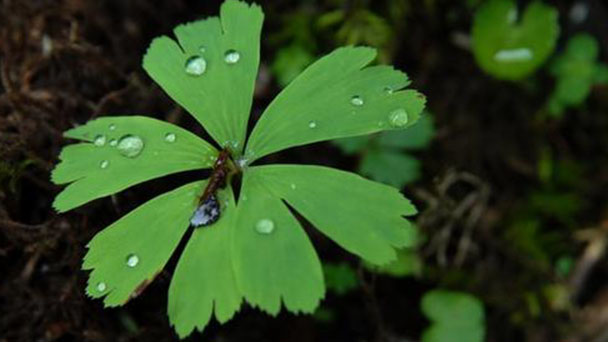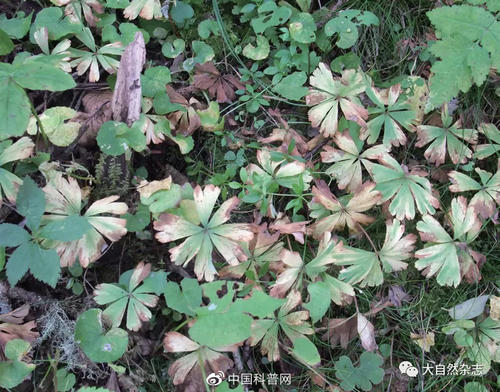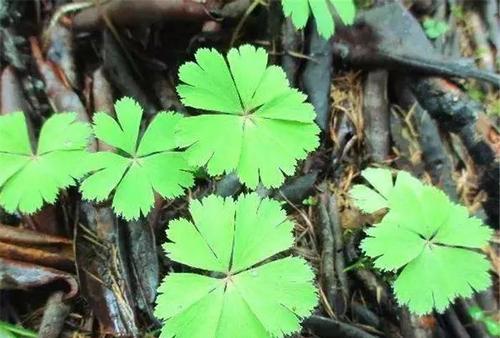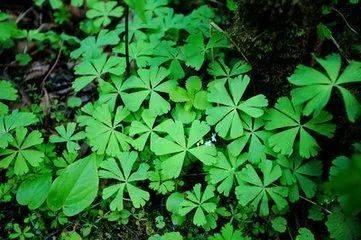Kingdonia uniflora profile
Written by Maggie
Mar 24 2021

Kingdonia uniflora is a small perennial herb, glabrous. Due to the poor natural regeneration ability of Kingdonia uniflora, coupled with the destruction and mining of the forest, the number of plants gradually decreased and the natural distribution decreased day by day. It is a rare species under national first-class protection.
Kingdonia uniflora picture

Morphological characteristics of Kingdonia uniflora
Leaf
Kingdonia uniflora leaves are basal, long stalk, leaf cord-shaped round, 3.5-7 cm wide, pentaclofid, middle and lateral whole lobes three lobes, the lowest whole lobes unequal two deep lobes, veins were bifurcated branching, and ginkgo biloba leaf similar, has important research value. Apical margin with small teeth, back flour-green, petiole 5-11 cm long.
Flowers
The Scape of Kingdonia Uniflora is 7-12 cm tall. Flowers ca. is 8 mm in diameter; Sepals are (4-)5-6(-7), pale green, ovate, 5 -- 7.5 mm long, apex acuminate; Stamens are 1.6-2.1 mm long; Stamens are 2-3 mm long, anthers ca. 0.3 mm; Carpel ca. is 1.4 mm, style subequal to ovary.
Fruit
Kingdonia uniflora Achenate, narrowly oblanded, 1 -- 1.3 cm long, 2.2 mm wide, persistent styles 3.5 -- 4 mm long, inverted, barbed, seeds narrowly elliptic, ca.3 mm long.
Ecological habits of Kingdonia uniflora
Kingdonia uniflora is an environment-dependent plant that mainly propagates asexually. It only lives in coniferous forests or broad-leaved forests in middle and high mountain areas. Kingdonia uniflora requires cool and wet climate and deep humus soil, so it is difficult to protect it ex - site.
The Kingdonia Uniflora static life table shows that the dynamic trends of mortality and survival rate of different populations are basically the same and adapt to environmental changes. When young, dx, qx and Kx are negative numbers; The mortality rate increased when the population reached 3-5 ages. Stable mortality after 8 to 10 years of life is a basic characteristic of the Kingdonia Uniflora population life table. The population dynamics of Kingdonia uniflora were affected by environmental factors. The population density increased, the mortality peak was delayed and the individual life span was prolonged with the elevation of Kingdonia uniflora. The populations of Kingdonia uniflora were more suitable under the Bashan fir forest and the Taibai redwood forest than under the Birch forest at an altitude higher than 2700m. If the age of maximum population density is taken as the starting point, the survival curves of different Kingdonia uniflora populations all belong to the Deeveyc type.
Cultivation of Kingdonia uniflora
Kingdonia uniflora has a special growth environment, and its seeds are difficult to be harvested. Artificial cultivation experiments have not been carried out in the past. In the future, we should focus on the protection of natural resources and promotion of natural renewal. At the same time, the rhizome can be transplanted in a similar environment, and the study of fruiting biology and seed propagation can be carried out to introduce and acclimate the species.
Under the current conditions, human disturbance should be minimized to protect the environment for the survival of Kingdonia uniflora, and special attention should be paid to the protection of the communities of Birch vulgaris, Abies basanica and Sequoia taibai, so as to create conditions for the survival and expansion of Kingdonia uniflora. Until the problem of successful artificial breeding of Kingdonia uniflora at low altitudes is solved, it is not advisable to promote introduction and cultivation or other forms of ex situ conservation.

Protection of Kingdonia Uniflora
Endangered
Because Kingdonia uniflora grows under subalpine to alpine primary forests and in shady, moist and deep humus environments, most seeds can not mature, mainly rely on rhizomes to propagate, and the natural regeneration ability is poor. In addition, man-made destruction of forest vegetation and mining have reduced the number of plants and reduced the natural distribution.
The endangered reasons
The growth and development of Kingdonia uniflora population components are affected by many environmental factors. The environmental factors that affect the growth and development of Kingdonia uniflora population components are mainly human disturbance, light, air temperature, air humidity, soil pH value, soil moisture, community coverage, humus thickness and other natural factors. The Abies fir forest at the altitude of 2700-2900 was a suitable habitat for the growth and development of Kingdonia uniflora with less human disturbance. In the area of 2500-2700, the soil humus layer under the birch forest was thin, and there were many human disturbances. The individual life of Kingdonia uniflora was short, and the components of Kingdonia uniflora were not fully developed, which showed degradation. The species of Kingdonia uniflora was between 2900-3100, but the severe climatic conditions at high altitude may be a limiting factor. The species of Kingdonia uniflora was between the two populations.
Protection value
The morphological and anatomical characteristics of vegetative leaves, rhizomes and perianth pieces are different from those of other genera of Ranunculaceae. This primitive angiosperm has a scientific significance in the study of the evolution of angiosperms and the phylogeny of Ranunculaceae.
Protection measures
Nature reserves that have been established should be listed as protection objects, and protection zones should be delineated in concentrated areas.
The distribution area of Kingdonia Uniflora
Kingdonia Uniflora is scattered in Taibai County and Meixian County, Shaanxi Province, Diebu, Zhouqu, Wenxian County, Gansu Province, Malkang, Maowen, Jinchuan, Nanping, Luding, Songpan, Emei Mountain and Deqin County, Yunnan Province.In the area of elevation 2200-3975 m subalpine to alpine coniferous forests and mixed coniferous and broad-leaved forests.
Kingdonia Uniflora distribution area has high altitude and cold climate. Most of the producing areas spend more than half of the time below 0℃, and the highest temperature in summer is only about 20℃. The soil is humus soil, good aeration, slightly acidic, thickness of 10-30 cm. Leaves of the Kingdonia uniflora under the forest, weak light, air and soil moisture.

Latest Updated
- Benefits of Bugleweed - 7 Science-backed Health Benefits
- Bugleweed Dangers & Side Effects - Is It Poisonous?
- How to Plant Evergreen Trees - What You Should Know
- When to Plant Evergreens - Grow Guide for Evergreen Trees
- 12 Wonderful Evergreen Shrubs for Your Garden
- 12 Popular Evergreen Plants with Pictures for Beginners
- When And How To Prune A Lilac Bush Like a Pro
- How to Grow & Care for Lilac Vine (Hardenbergia Violacea)
- Japanese Lilac Tree (Syringa Reticulata) Care & Propagation Guide
- Shumard Oak Pros and Cons - What to Know
Popular Articles
- Winter maintenance of Antirrhinum Majus
- How to Grow Terminalia Mantaly Tree
- How to Grow and Care for Crossostephium Chinense
- How to grow Antirrhinum Majus in spring
- Peristeria Elata (Dove Orchid) Profile: Info & Care Guide
- Underwatered Snake Plant (Sansevieria Trifasciata) - Signs And How To Fix
- How to Care for Brazilian Jasmine Plant (Mandevilla Sanderi)
- How to Grow & Care for Graptopetalum Purple Delight in Summer
- Rosa Chinensis (China Rose): Plant Growing & Care Tips
- How to Care for Baby Sun Rose (Aptenia Cordifolia)